Cross-pollinating new art techniques, sound, technology, and video, Lee Blalock explores a variety of critical and complex topics that confirm our society’s immersion into a time-period which many are now defining as “posthuman”. The first week of 2016, The COMP Magazine visited Blalock’s Bryn Mawr studio to discuss her unusual route in establishing her current aesthetic investigations, the similarities between a lab and studio, her highly layered performance and video work, and the intersection of art, technology, and the future.
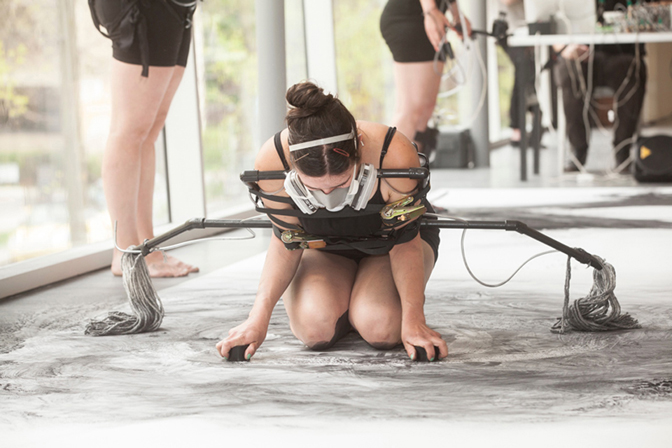
Lee Blalock, “Notation for Neue Movement Fidelity, No.1”, 2013
Performance documentation. Hyde Park Art Center
photo: Michael E. Smith
You have a fairly unconventional history and trajectory for an artist. You grew up in Philly, studied chemistry and math at Spelman College, design at Bauder College, worked in advertising and eventually landed in Chicago to complete your MFA at SAIC. Can we perhaps start with how these events inform your current aesthetic practice? Are there any specific events that initiated your investigations?
I grew up in a little place near South Philly called Chester. I started out in undergrad pursuing a dual degree in Engineering and I switched to Chemistry and Math after my second year because I couldn’t get a handle on what options would be open to me after graduation. Thanks to Youtube, now there are so many practical examples of how an engineer spends their day that I almost wish I could have a do-over. After undergrad, I worked for IBM, and I worked the third shift. But I spent all of my down time looking at design magazines so I ended up enrolling in a design program at Bauder (fashion and graphic design). I’d go to work from 11pm to 7am, then go to school from 9am to 4pm. I was also a club kid at the time, so I got no sleep, but it was totally worth it. I ended up with some pretty tight graphic design skills and a line of clothing that was carried in some Atlanta stores. That got me a gig at a creative agency where I stayed for 10 years. I started as a fashion stylist then moved into a job as an art director before helping to develop the video department. It was one of the best jobs I’ve ever had because it was my first studio. We all had keys to the building and had access to both the still and video cameras and all of the sets and props. So, I’d work for our clients during the day and shoot weird stuff at night. I was dancing at a studio in my down time, so I’d set up a tripod and shoot myself doing movement based stuff, or I’d invite my dance friends in for an experimental project. I already made most of my images using a computer, and the agency had the equipment I needed to learn new photography techniques. When I ended up learning video for our clients, it opened up a whole new way of making images for my own work. I should mention that is during the big shift most companies made from film to digital media. It’s right before we all started carrying good quality video cameras in our pockets. I’d made a ton of video art pieces at the agency and I’d make the soundtracks using some of the techniques I’d learned designing sound for clients. These videos ended up being my grad school portfolio. So by the time I got to SAIC, I had tightened up my digital chops and was concentrating on the context and history that I now had access to. I’d been around technology all of my life (my dad was a programmer and computer operator back when they used punch cards). All of my technical and philosophical interests seemed to converge perfectly in the arts. I can see the trajectory as less of a straight line now and more of a circular path. As far as my aesthetics go, I’ve always wanted to author my own origin stories. If I were to simplify, I’d say that I don’t understand the world. So, I’m interested in building worlds, in making images I may not have seen, in describing behavior rather than bodies, or re-designing bodies, and in seeing my reflection through machines or numbers or science fiction. Certainly, sound plays a big role in my work as well. I grew up watching MTV when it first debuted. So, I almost always hear images and see music and sound. I write a lot of programs in my work that make those mediums work together the way I want them to. I have a special relationship to sound. Some sounds irritate me. It’s called misophonia. Making sound gives me an opportunity to gain some control back, to make my own sounds rather than having to constantly defend myself against sounds that make my blood boil.
![Lee Blalock, Stills from “Stereo Test Program No. 1 [for Multiples]”, 2013 https://vimeo.com/137911473](http://www.thecompmagazine.com/wp-content/uploads/2016/01/stereo1.jpg)
Lee Blalock, Stills from “Stereo Test Program No. 1 [for Multiples]”, 2013
https://vimeo.com/137911473
![Lee Blalock, Stills from “Stereo Test Program No. 1 [for Multiples]”, 2013 https://vimeo.com/137911473](http://www.thecompmagazine.com/wp-content/uploads/2016/01/stereo2.png)
Lee Blalock, Stills from “Stereo Test Program No. 1 [for Multiples]”, 2013
https://vimeo.com/137911473
During my visit I felt that your studio functioned more like a lab, rather than a traditional artist’s studio. Can you share with us some insight into your working practice?
I don’t really separate the two. I think most studios are labs. In fact, I refer to the space as The Lab. Nothing about my studio is traditional. I found this awesome place in my neighborhood. In fact, it’s across the street from my apartment, in an active church. Perfect. I always feel like that character Nightcrawler from the X-Men when I’m there. I’ve shared spaces with other artists before, but I really do benefit from a vacuum when I’m working. I find it hard to experiment when anyone else is around. I’m there everyday, at all times of the day. I don’t feel much separation between what happens in my apartment and what happens in my studio because the studio is like 30 feet from my apartment. That was my goal, though. I wanted my practice to be integrated with my life. I’m able to work easily on digital platforms because I just store everything in the cloud and pick up where I left off in either place. I do, however, dedicate the studio to any fabrication (electronic or otherwise) or anything that makes a ton of noise (all of my midi controllers, drum machines, instruments are there because the walls are impossibly thick). The space is big enough for performance rehearsals. And since I have access to most of the building, it’s a good place to shoot source material. And when I need a break over there, we have a full sized gym, so I shoot hoops when I need to think. When my studio was further away, I used to only go in when I had a whole day’s worth of things to accomplish. That’s changed since I got the new spot. I find that being able to run back and forth for any amount of time at any time of day actually works better for my way of working. It feels more like home in a way that it never has in any other studio space.
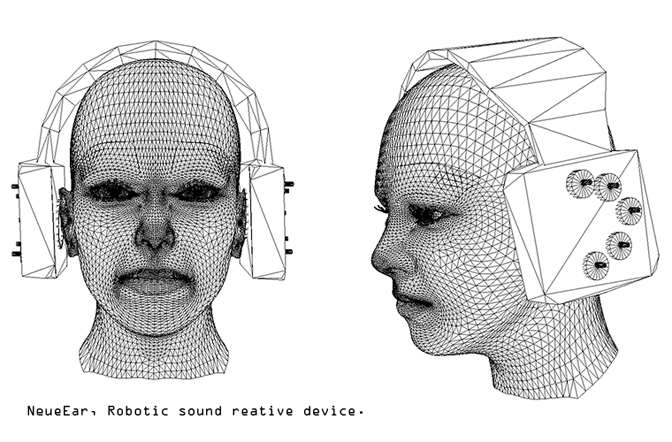
Lee Blalock, Proposal and detail shots from “NeueEar” project, 2014
http://leeblalock.com/neueear.html
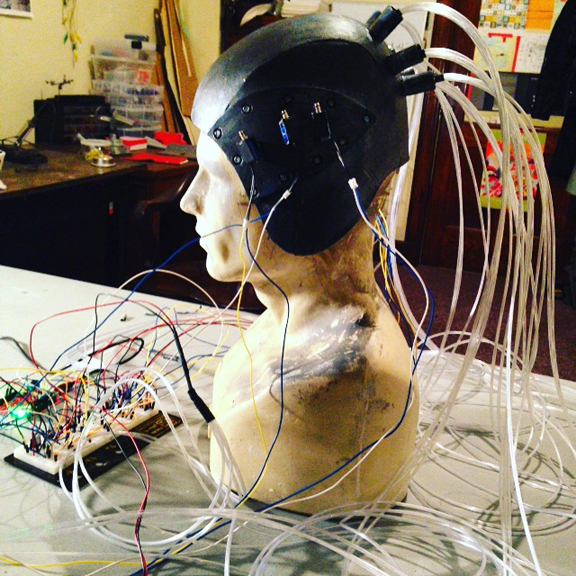
Lee Blalock, new work in progress, 2016
I’m curious about the work 3m Reel. This highly layered video appears to consist of seemingly disparate video clips that have been appropriated (edited) or created by you. There is the obvious connection to technology, however my interest resides with wanting to understand the process of selection and the message of the artwork. Can you assist in this query?
I had to think about this for a minute! That’s just a link to 3 minutes of moving image work I’ve done. It’s just a sample reel that I update a couple times a year. Almost all of it is programmed or shot by me. There’s one shot that I got from an old NASA archive that I processed and used for the oddity() performance at the MCA. It’s just a reel. No message.
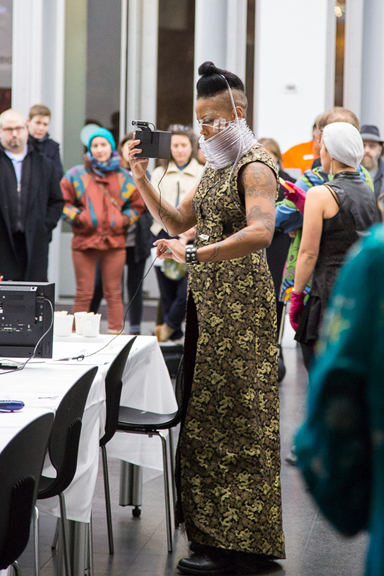
Lee Blalock, “oddity()”, 2014
Performance documentation. Part of the MCA “Bowie Is” live programming
(RIP Major Tom)
photo: Michael E. Smith
What impact do you see art + technology and related investigations having upon how artists are interpreting, interacting and presenting insight into contemporary society?
That’s a pretty broad question, I think. The art + technology umbrella is huge. I think you’d find that artists are hitting all the important topics regardless of the way we use technology: privacy, social networks, war technology, politics, and identity, among other things. On the one hand, the question implies a certain degree of separation from other processes. But, I think it’s important to consider that technology can offer a way to think through materials that feel native to the way an artist processes information. Just like drawing. Looking at my site, I’m sure you noticed that I work in various different ways. Conceptually, I’m almost always coming from some computational perspective, but that may end up being the source for a drawing or a live performance, and not the destination. In other words, insight is insight. On the other hand, and I’m speaking only for myself here, I think technology offers an interesting way to do all of that world building I mentioned above. It seems that people need/want to label one another now more than I have ever noticed before. You are (x1,y1). He is (x2, y2). That guy over there is from (x3, y3, z3) and that means blah, blah, blah. You know? I see abstraction through technology + virtuality as a form of liberation. For me, it’s a response to what feels like chaos and restriction in the real world (and I use that word ‘real’ loosely). Seems counterintuitive doesn’t it? Since computation is based on rules. But I’m talking about perception and expression here. Simulation as a new kind of emancipation. Who knows, that may be true for other artists as well.
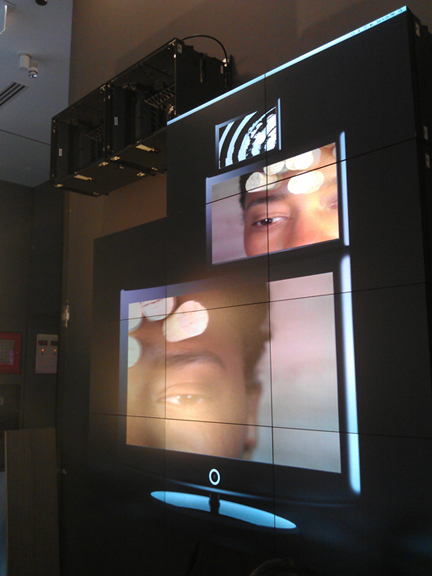
Lee Blalock, “Remote”, 2012
Video installation Documentation
Shot of piece being installed on Christie Microtiles at the Neiman Center, SAIC.
In addition to your art practice, you are now teaching. Are there any items that you have learned in your studies that you share with your students?
I was very lucky to have been able to teach as soon as I graduated. It’s something I’ve always wanted to do. I’ve always loved being in school. To be honest, two years just isn’t enough time to hang around your mentors and advisors. So teaching at my alma mater just means I get to extend my own experience. I’m also happy to be able to teach directly from my practice. My technical courses are based around computational topics and my research and seminar classes are based on topics of new media and the posthuman. My home library has gotten out of control thanks to Amazon 1-click. I’m nowhere near caught up the way I thought I’d be over winter break.

Lee Blalock, Screengrab
Testing a program to be used in an interactive performance
What are you currently working upon? Do you have any upcoming exhibitions, performances or webcasts?
I built a 4ft cube in my studio in the fall so that I could do remote performances from this very small space (I’m 5’10”). I’m currently working on making it a fully functional system. As a reference, think of astronauts in the ISS. I’ve named it “Capsule”. Part of this experiment is due to a need to perform on my own terms and in my own space, with a dash of escapism as in “Please Thor, hide me from this confusing planet!”. Either way, it’s a great opportunity for some practical work. So, I’m making something that resembles a modular synth, but something that handles sounds, images, and interactivity. The piece you saw when you came to The Lab was part of the first of many modules. It’ll definitely manifest as a video before it’s ready to be any kind of live performance. Outside of my own practice, a dancer and musician friend named Ally Subak and I have a performance art rock/tronic project called Dress the Doll which we’re writing songs for now. Ally participated in my oddity() performance last year and we both got a taste for experimental performance centered around music. We haven’t posted any of the current songs and videos online yet, but we will soon. There are some other things in the pipeline for 2016. I’ll keep you posted once they’re confirmed.
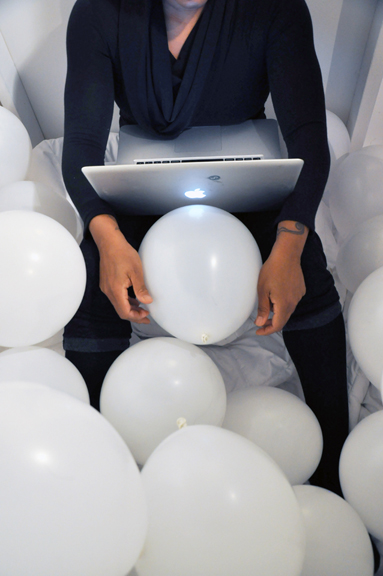
Lee Blalock, art + technology artist, Chicago, IL, 2016
photo: Chester Alamo-Costello
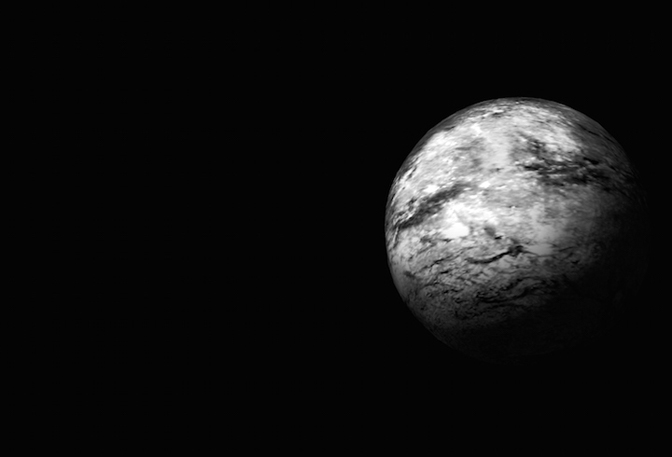
Lee Blalock, “Neue 5yst3ms: Plan3tary Bodies”, 2015
Microscopy, 3d model, digital print
For additional information on the work of Lee Blalock, please visit:
Lee Blalock – http://leeblalock.com/
Soundcloud – https://soundcloud.com/leeblalock
Vimeo – https://vimeo.com/channels/lee
![Lee Blalock, “Capsule1 [in flight, in pieces]”, 2015 Screen grab from real time remote performance for “PER_FORM” at the Chicago Art Department. https://vimeo.com/142005303](http://www.thecompmagazine.com/wp-content/uploads/2016/01/capsule1.png)
Lee Blalock, “Capsule1 [in flight, in pieces]”, 2015
Screen grab from real time remote performance for “PER_FORM” at the Chicago Art Department. https://vimeo.com/142005303

Lee Blalock, “Neue An4t0_Me Vol. 1”, 2015
A hardcover, perfect bound copy of the jpeg code of a microscopic image from my body with some of the code changed to replace certain symbols with my moniker
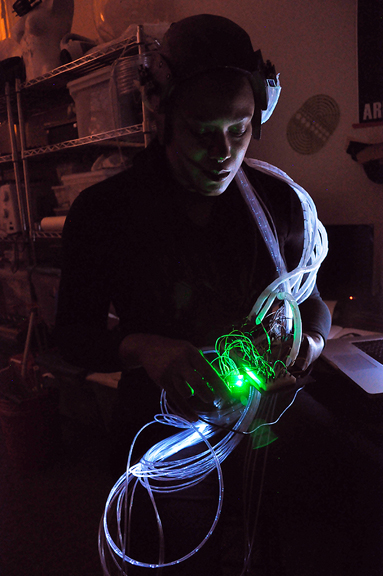
Lee Blalock, art + technology artist, Chicago, IL, 2016
Interview and portrait by Chester Alamo-Costello


